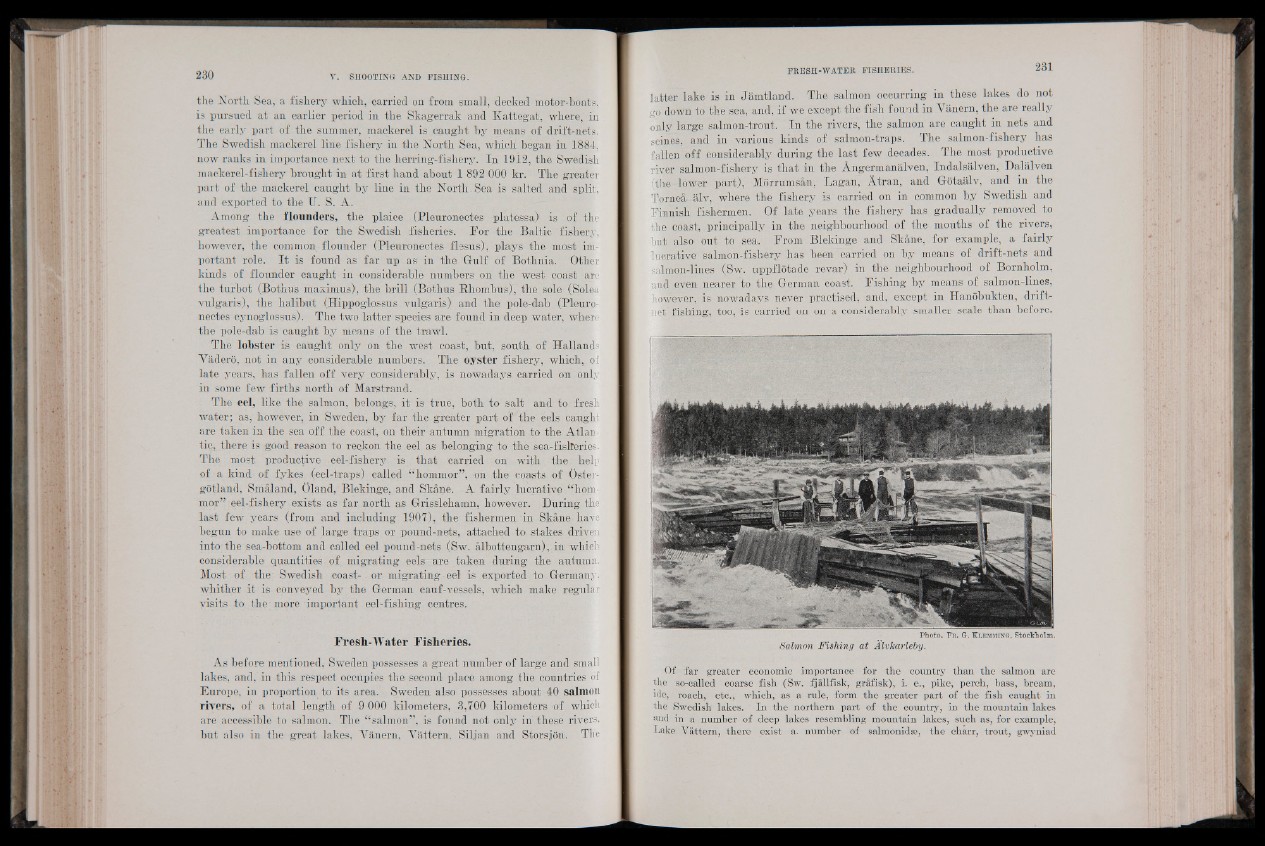
the North Sea, a fishery which, carried on from small, decked motor-boats,
is pursued at an earlier period in the Skagerrak and Kattegat, where, in
the early part of the summer, mackerel is caught by means of drift-nets.
The Swedish mackerel line fishery in the North Sea, which began in 1884,
now ranks in importance next to the herring-fishery. In 1912, the Swedish
mackerel-fishery brought in at first hand about 1 892 000 kr. The greater
part of the mackerel caught by line in the North. Sea is salted and split,
and exported to the U. S. A.
Among the flounders, the plaice (Pleuronectes platessa) is of the
greatest importance for the Swedish fisheries. For the Baltic fishery,
however, the common flounder (Pleuronectes flesus), plays the most important
role. It is found as far up as in the G-ulf of Bothnia. Other
kinds of flounder caught in considerable numbers on the west- coast are
the turbot (Bothus mazimus), the brill (Bothus Rhombus), the sole (Solea
vulgaris), the halibut (Hippoglossus vulgaris) and the pole-dab (Pleuronectes
cynoglossus). The two latter species are found in deep water, where
the pole-dab is caught by means of the trawl.
The lobster is caught only on the west coast, but, south of Hallands
Väderö, not in any considerable numbers. The oyster fishery, which, (of
late years, has fallen off very considerably, is nowadays carried on only
in some few firths north of Marstrand.
The eel, like the salmon, belongs, it is true, both to salt and to fresh
water; as, however, in Sweden, by far the greater part of the dels caught;
are taken in the sea off the coast, on their autumn migration to the Atlantic,
there is good reason to reckon the eel as belonging to the sea-fisheries.
The most productive eel-fishery is that carried on with the help
of a kind of fykes (eel-traps) called “hommor”, on the coasts of Öster-
götland, Smäland, Öland, Blekinge, and Skäne. A fairly lucrative “hommor”
eel-fishery exists as far north as Grisslehamn, however. During the
last few years (from and including 1907), the fishermen in Skane have
begun to make use of large traps or pound-nets, attached to stakes driven
into the sea-bottom and called eel pound-nets (Sw. albottengarn), in; which
considerable quantities of migrating eels- are taken during the autumn.
Most of the Swedish coast- or migrating - eel is exported to Germany,
whither it is conveyed b y the German cauf-vessels, which make regular
visits to the'more important eel-fishing centres.
Fresh-Water Fisheries.
As before mentioned, Sweden possesses a great number of large and small
lakes, and, in this respect occupies the second place among the countries of
Europe, in proportion to its area. Sweden also possesses about 40 salmon
rivers, of a total length of 9 000 kilometers, 3,700 kilometers of which
are accessible to salmon. The “salmon”, is found not only in these rivers,
but also iu the great lakes, Van ein, Vättern, Siljan and Storsjon. The
latter lake is in Jamtland. The salmon occurring in these lakes do not
go down to the sea, and, if we except the fish found in Vanern, the are really
only large salmon-trout. In the rivers, the salmon are caught in nets and
seines, and in various kinds of satmon-traps. The salmon-fishery has
fallen off considerably during the last few decades. The most productive
river salmon-fishery is that in the Angermanalven, Indalsalven, Dalalven
(the -lower part), Morrumsan, Lagan, Atran, and Gotaalv, and in the
Tornea-alv, where the fishery is carried on in common by Swedish and
Finnish fishermen. Of late years the fishery has. gradually removed to
the coast, principally in the neighbourhood of the mouths of the rivers,
but also out. to sea. From Blekinge and Skane, for example, a fairly
lucrative salmon-fishery has been carried on by means of drift-nets and
salmon-lines (Sw. uppflotade revar) in the neighbourhood of Bornholm,
and even nearer to the German coast. Fishing by means of salmon-lines,
however, is nowadays never practised, and, except in Hanobukten, drift-
net fishing, too, is carried on on a considerably smaller scale than before.
Ph o to . F r . Cr. F l e m m i n g , Stockholm.
Salmon Fishing at AlvJcarlehy.
Of far greater economic importance for the country than the salmon are
the so-called coarse fish (Sw. fjallfisk, grafisk), i. e., pike, perch, bass, bream,
ide, roach, etc., which, as a rule, form the greater part of the fish caught in
the Swedish lakes. In the northern part of the country, in the mountain lakes
and in a number of deep lakes resembling mountain lakes, such as, for example,
Lake Vattern, there exist a. number of salmonidse, the charr, trout, gwyniad